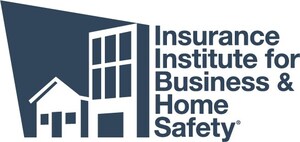New versions of FORTIFIED standards strengthen requirements for inland structures
RICHBURG, S.C., Nov. 21, 2024 /PRNewswire/ -- The Insurance Institute for Business & Home Safety (IBHS) today released the 2025 FORTIFIED Home™, FORTIFIED Commercial™ and FORTIFIED Multifamily™ construction standards. All three standards are updated periodically to align with building codes and design standards. Since its inception in 2010, the FORTIFIED program has set the benchmark for beyond-code construction and re-roofing, designed to reduce storm damage by strengthening areas of homes, commercial buildings and multifamily properties typically vulnerable to high winds and heavy rain.
In the updated standards, the requirements for a FORTIFIED Roof™ designation in inland areas will be more consistent with requirements in hurricane-prone areas. All FORTIFIED roof decks will now have the tighter nailing pattern, and all roof-mounted vents will have to meet testing standards showing they prevent wind-driven rain from entering a building. These requirements, which have proven effective against hurricanes, will increase performance of residential and commercial structures as well as reduce the risk of damage from severe convective storms, including derechos, tornadoes and straight-line winds.
"When we looked at the recent severe weather events that impacted inland states, we realized much of the interior damage could be reduced by strengthening the roof system," said Fred Malik, managing director of FORTIFIED. "Our market research found materials and methods long used on the coast to prevent damage are now consistently available in inland markets, so it is the right time to make this shift."
Additional notable changes under the updated standards include a requirement that steep-roofed structures with asphalt shingles must use a product rated as "Excellent" or "Good" on the IBHS Impact-Resistant Shingle Performance Ratings to be eligible for the hail supplement to a FORTIFIED designation. This optional, but important, requirement provides property owners with confidence their roof can withstand hail up to two inches in diameter. Prior versions of the FORTIFIED standard allowed the use of asphalt shingles with a UL 2218 Class 4 impact rating, if they had not been tested by IBHS. The IBHS protocol uses manufactured hail to test shingles under more realistic conditions than traditional testing.
The 2025 FORTIFIED Home Standard also requires that roofs be installed by certified FORTIFIED roofing contractors.
"Trained and certified roofers are, on average, more successful at achieving FORTIFIED designations than roofers who aren't. So, it's in the best interest of homeowners for us to make this change," says Malik. "And with reasonably priced, self-paced training available online, interested, qualified roofing contractors should have no trouble meeting the requirement."
Many of this year's other updates to the FORTIFIED standards relate to changes in American Society of Civil Engineers' ASCE 7, which FORTIFIED and most building codes use to set minimum design load requirements. The 2025 FORTIFIED standards also incorporate clarifying language or amendments issued through FORTIFIED technical bulletins since the current versions were released.
"Our FORTIFIED team works to integrate the latest research conducted by IBHS and other industry experts, like ASCE, into our building standards," said Chuck Miccolis, managing director of commercial lines at IBHS. "Staying on the leading edge and making the best mitigation strategies available to property owners and contractors across the country is key to our mission to reduce avoidable losses caused by severe weather."
Based on decades of scientific research, FORTIFIED offers three progressive levels of protection for new and existing buildings, tailored to specific weather hazards. By studying homes impacted by severe weather, IBHS identifies common construction weaknesses and tests solutions at the only research center capable of subjecting full-scale structures to realistic storm conditions, including wind-driven rain, hail and high winds. Detailed information on the updated standard, including a summary of key changes and updated technical resources such as standard details, calculators and documentation checklists, is available on FORTIFIEDHome.org.
Contractors seeking a FORTIFIED Home designation can begin implementing the new standard on January 1, 2025, and compliance will be required by November 1, 2025. The transition period allows contractors and evaluators, who document compliance on each FORTIFIED project, to prepare for the new requirements. Because of the lead time involved in projects, developers seeking a FORTIFIED Commercial or FORTIFIED Multifamily designation will be required to meet the updated standard if their application is dated after January 1, 2025.
"The 2025 FORTIFIED standards reflect the latest high wind research conducted by IBHS, along with input from other experts and building industry stakeholders," Malik said. "They lay out proven strategies for improving the durability of single-family homes, multifamily and commercial developments addressing wind, wind-driven rain and hail."
Approximately 70,000 properties across 31 states have been built or re-roofed using FORTIFIED, including 15,000 buildings this year. "This progress reflects the growing recognition of the importance of resilient construction in protecting homes and communities from severe weather," Malik added.
Learn more about the updated 2025 FORTIFIED Home standard at https://fortifiedhome.org/2025-technical-documents/.
About the Insurance Institute for Business & Home Safety (IBHS)
The IBHS mission is to conduct objective, scientific research to identify and promote effective actions that strengthen homes, businesses and communities against natural disasters and other causes of loss. Learn more at IBHS.org.
About FORTIFIED
FORTIFIED is a voluntary, beyond-code construction and re-roofing method to strengthen homes and businesses against severe weather, including high winds, hurricanes and tornadoes. Visit fortifiedhome.org to learn more about the program, including the designation process.
SOURCE Insurance Institute for Business & Home Safety

WANT YOUR COMPANY'S NEWS FEATURED ON PRNEWSWIRE.COM?
Newsrooms &
Influencers
Digital Media
Outlets
Journalists
Opted In



Share this article